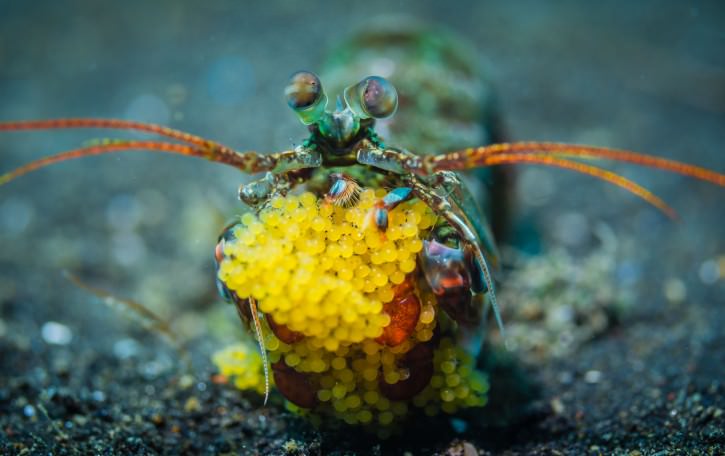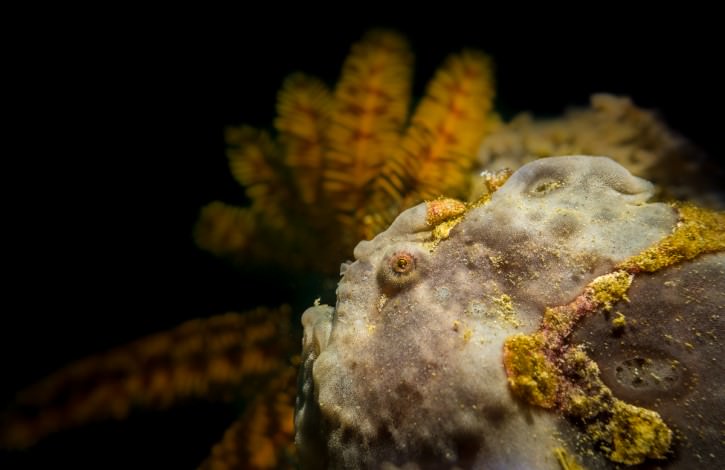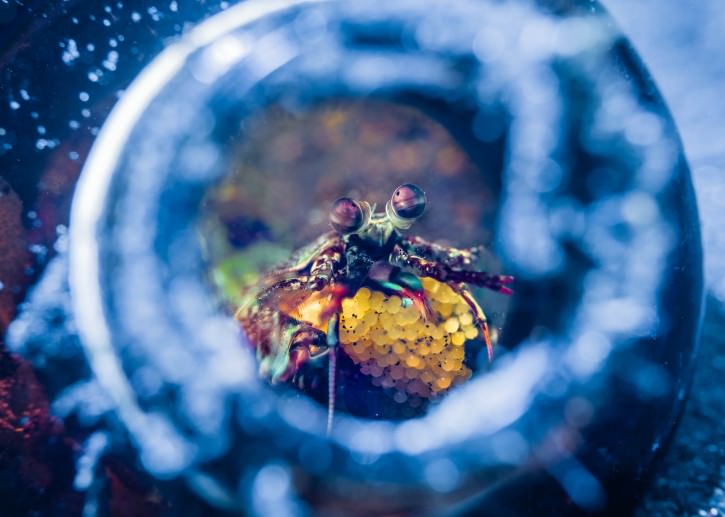Photo / Video News & Reviews
How much is a photo worth?

[hr style=”single”]
I originally wrote this article around three years ago, after a great Lembeh trip marred only by this particular event, and have decided that it’s a very topical issue with some of the luminaries of the underwater photography world now at loggerheads about this sadly on trend bad behaviour.
I must thank Alex Tattersall for a great talk about this at DIVE 2016 which I must fess up I didn’t see personally but enough of my friends did and reported back to me. He was also being brave enough to come clean about his own past indiscretions, and pointing out miscreants still directly doing this sort of thing, or allowing it to happen and thus condoning it.
On my first trip to Indonesia I was aware of the guides willingness to orchestrate the marine life for the benefit of the photographer, but to be totally honest I have never done this myself and have always called them out on it. That is if I was aware of it.
Looking back now, there was more than one occasion that I have had my attention alerted to the most incredibly positioned nudibranch, and now in retrospect I think that the murkier waters of the Lembeh Straits and those surrounding Manado have perhaps served the purpose of hiding this sort of thing in less than plain viz.
[hr style=”single”]

I really do wonder now if all the wonderfully positioned nudibranchs that I’ve had pointed out to me really were in such great positions. Sadly all this manipulation talk has now made me doubt a lot of these shots, mine included.
Prime Witnesses
I wasn’t the only one to witness this event, and in the great scheme of things it amounts to very little.
Unfortunately though it does point to a worrying trend in the world of underwater photography that I feel strongly about.
Not all share my views, granted – so by all means let your own conscience guide you.
Because of the events behind the couple of pictures I took, I could never with good conscience post these pictures without also giving the backstory to them, which really changes things quite a lot for me.
It has made me wonder how many others would do the same, when presented with the opportunity, to get a fairly unusual and unique shot in similar circumstances.
And also, how many others have taken pictures that I have been inspired by and wondered at, that are now tainted with the doubt that all may not be quite as it seems?
Maybe I’m just incredibly naive, and this is my wake up and smell the coffee moment.
OK: Here’s the story

The dumping grounds that are the Lembeh Straits are famed for the diversity of marine life of all shapes and forms, and discarded bottles actually make great shelters and homes for lots of creatures.
Towards the end of a dive in the Lembeh Straits, famed for its incredible diversity of weird and wonderful marine life, myself and some friends and fellow work shoppers were pootling about in the shallows.
One of our guides – unfair to name him – signalled for our attention as they do by tapping on his tank with his pointer.
He was about 20m distance and invisible to us, as the visibility was less than 10m. Nevertheless we found him quickly.
He pointed triumphantly to a small Mantis Shrimp on the sand, completely exposed.
We saw no burrow and there was no obvious shelter for this creature. They have a tendency to be quite shy, but often also a little inquisitive, so seeing one completely out of its hole was odd, but still appeared quite a credible scenario.
Being photographers we felt lucky that this particular individual was in a great position to get a shot.
As I lined up for the picture I realised through the magnified screen image that it was clutching a mound of eggs.
Amazing I thought, what are the chances of that eh?
I had previously only encountered egg holding Mantis hiding under ledges, and always inaccessible to me in the past.
I had cause a few years earlier to actively prevent a guide from removing one from its mound by poking it out with his pointer stick, and upon admonishment post dive he said that if I wanted to guarantee a shot of one with eggs then this was a sure fire method, and worse still that he had done this dozens of times before for other photographers from all four corners of the globe… without any previous complaints!
Anyway, back to the current situation. I took a shot and my dive buddy Phil waved and pointed behind me – our guide had moved on.
Coming from a broken home
Behind me and a few metres from our transfixed shrimp was the fragments of a broken beer bottle, the neck and the base still intact, but the middle clearly broken with the contents of sand and fragments of shells and remains of small creatures now scattered around.
I have encountered Mantis shrimps living in glass bottles before, and I was lucky enough to get a shot of one living inside an intact bottle last year, which I was even more chuffed with because I’d found it myself without the help of a guide.
So I will regularly check the discarded beer bottles and other containers that make for a great des-res for marine life when diving the underwater dumping grounds that actually make Lembeh such a fascinating and contrary place to dive.
On closer inspection of the shards of broken glass, they looked very freshly broken to me with no dirt build up and very sharp clean edges.Putting two and two together a horrible possibility dawned upon me… that someone had actually broken this bottle and frightened the expectant creature out into the open.
Phil clearly thought the same signalling as such, and to underline this thought, the poor shrimp scuttled back into the neck of the bottle.
I took a shot of it in there with its eggs, and resolved to only publish the picture with this story attached, as my conscience wouldn’t let me do anything other.
Bottle Half Empty
Phil gently pushed the rear of the neck of the bottle back into the sand affording her some protection from the rear, but now her home was a quarter of the size it was shortly before.
We left her be and returned sadly to the surface, where our guides were slowly making their way ahead of us back to the boat.
Now, bearing in mind I have absolutely no proof of our guide’s part in all this, I kept mum, and didn’t let my anger get in the way of rationale. I didn’t need to bring the subject up though, as the guide in question, with a big smile on his face, brought up the Mantis Shrimp find himself – almost triumphantly.
I asked him how he had found it, and he said it was just there resting on the sand. I mentioned finding the bottle and he said he hadn’t seen it, which I doubted in the circumstances. He then contradicted himself by saying that he had seen the broken bottle and it must have been broken by guides on the other boat moored close by.
I have no way of knowing for definite if he was or wasn’t telling the truth, but I am sure that this bottle, intact, had been her home very recently before we saw her out and exposed, and someone had broken the bottle; who, we will never know for sure. What is worse is that it was broken by parties unknown for the benefit of photographers.
Is any photograph worth the wanton destruction of any creature’s habitat? Whoever broke this bottle thought so.
Are photographers such needy and demanding clients that the guides deem it necessary to go to these lengths to please their relatively wealthy clients?
This is not an isolated incident; I have seen other incidents of marine life manipulation for the benefit of photographer clients – not always as bad as this one, but in light of this they are the thin edge of the wedge I fear.

The underwater photographic community at large needs to try and police ourselves and each other and show intolerance for manipulating marine life. We often give people a hard time for digitally manipulating the underwater realm, but surely pushing the pixels is a small crime by comparison?
[hr style=”single”]
At the time the only possible solution that I could think of that was appropriate in the circumstances was to suggest that the ‘big guy’ watching over everything knew what had happened, as he sees everything.
I’m not in the slightest bit religious personally but am aware that in this part of Indonesia everyone is devoutly christian, so I thought it would maybe make them think a bit if they had done exactly what we thought they had. If they hadn’t then no harm done, they would have clear consciences – but I did notice a fearful look flash across one of their faces, so perhaps my impression was right.
As mentioned in the update at the start of this post, we have come along quite a way since I originally wrote this blog and it has now become the current hot topic, with not only underwater photographers being held to account but also a slew of on land photographers getting up to all sorts of tricks to, in most cases, win big money prizes for their tawdry efforts.
So I’m glad it’s in the public eye, and just like the diving community no longer tolerates manhandling turtles and big fish and dolphins, we will hopefully come to abhor all sorts of manipulation for short term photographic and often financial gain.
I would also say that I don’t blame the guides completely for these actions as there is a massive disparity in income between them and their comparatively rich clients, and in the intervening years I have heard of a well known Far Eastern photographer actually having laminated cards printed with prices in US dollars in tips for the production of differing creatures on dives. This surely puts the guides under a lot of pressure, as $50 is a lot of money to them, which was the amount being flaunted as up for grabs if a hairy octopus was produced in one particular case that I heard of.
And it’s not just Far Eastern photographers doing it; I’ve heard of more than one European behaving badly to gain photographic kudos. One had a guide bring up specimens for them to shoot from greater depths than they were allowed to go because of PFO induced depth restrictions. Really?
I think the solution is easy: I would personally discourage the habit of having lists of desirable creatures, and just shoot what’s there, without any pressure on the guides to deliver, and to also tip based on an overt absence of manipulation at the culmination of a trip.
What to do about competitions though, often with huge payouts and at the very least kudos aplenty? The organisers and judges need to be very very careful with what they reward based on their own experiences and familiarity of the underwater world, and if there is the slightest sniff of doubt then they perhaps shouldn’t place a picture. It’s a shame and perhaps unfairly penalises the honest, but what else do you suggest?
[hr style=”single”]
 Duxy is the in house photo-pro for UK-based dive tour operator Scuba Travel. To find out about availability on Scuba Travel’s underwater photography workshops hosted by Duxy click here.
Duxy is the in house photo-pro for UK-based dive tour operator Scuba Travel. To find out about availability on Scuba Travel’s underwater photography workshops hosted by Duxy click here.
Blogs
13th Annual Ocean Art Underwater Photo Contest Winners Announced

The World’s Premier Underwater Photography Competition Announces Stunning Winners for 2024
The Ocean Art Underwater Photography Competition, widely regarded as the pinnacle of achievement for underwater photographers, has revealed its winners for 2024. With record-breaking participation from over 90 countries, the competition set a new standard for creativity and technical excellence. From mesmerizing macro shots of marine birth to dramatic wide-angle scenes of cenotes and reefscapes, the winning photographs highlight the beauty, fragility, and diversity of underwater ecosystems while inspiring global conservation efforts.

Honorable Mention, Black & White: Brittany Ilardi,
“Fevered”
Winning photos can be seen at the Underwater Photography Guide at https://www.uwphotographyguide.com/ocean-art-contest-winners-2024
Best In Show
The coveted Best in Show ranking was awarded to Eduardo Labat for his breathtaking image, “Dancing White Tips,” (see main image) taken at Roca Partida, Revillagigedo, Mexico. Labat’s photograph captured a synchronous ballet of white-tip reef sharks in black & white.
Category Highlights
This year’s winners excelled across 14 categories, two highlights included:
- Black & White: This category was highly competitive this year, celebrating the dramatic interplay of light and shadow in underwater photography:
- Conservation: This category featured the dramatic plight of Floridian springs as well as an image of a shark captured in a ghost net. This image symbolized the devastating impact of abandoned fishing gear and underscores the competition’s ongoing support for Ghost Diving, a nonprofit organization dedicated to removing marine debris.

4th Place Portrait: Ariel Gliboff,
“Family Portrait”
Behind the Lens
Every winning photograph tells a story of perseverance and connection to the ocean. These are just a small selection of the incredible stories and experiences told throughout the competiiton:
- Born from Mouth: Yoichi Sato recounts an incredible moment with a male Cardinalfish releases a swarm of freshly hatched babies from its mouth.
- Hunting: Kyungshin Kim’s recounts a captivating moment of squid cannibalism while floating in the open ocean at night.
- Fevered: Brittany Ilardi’s dramatic image of mobula rays off Baja California reflects the unique choreography of this species.
Organizers and Sponsors Speak
“This year’s Ocean Art competition was nothing short of extraordinary,” said Nirupam Nigam, organizer of the contest and President of Bluewater Photo & Editor-in-Chief of the Underwater Photography Guide. “The talent and vision displayed by our participants have set new benchmarks for underwater photography. These images do more than win awards; they captivate hearts and minds, reaching millions globally and reminding us of our shared responsibility to protect the ocean’s beauty. It’s an honor to see the competition grow in scope and impact every year.”
This year’s judging panel included world-renowned experts in underwater photography including Tony Wu, Marty Snyderman, and Mark Strickland. A special thanks goes to Canon and Marelux Ambassador Ipah Uid Lynn, who joined as a new judge to bring fresh perspectives to the Underwater Digital Art and Underwater Fashion categories. Ipah is an inspiring woman who has pushed the bounds of underwater photography in a male-dominated field. Marelux also played a key role in supporting the competition by sponsoring the top prizes for underwater camera gear.
Over $60,000 in Prizes
The Ocean Art Underwater Photography Competition has always been known for having a massive endowment – this year over $60,000 in prizes! Ocean Art prizes are provided by some of the world’s top scuba diving resorts, liveaboard dive yachts, and underwater photo gear manufacturers. Grand prizes include a 7-night dive package at Anthony’s Key Resort in Roatan, Honduras; an 8-day dive trip to the Galapagos aboard the Aqua Liveaboard; a 10-night liveaboard dive trip aboard the MV Oceania in Papua New Guinea; a 7-night liveaboard dive trip aboard the Bilikiki in the Solomon Islands; a 14-night dive trip to Ambon, Indonesia with Spice Island Divers; an 8-day/7-night dive package (12 dives) for two at Meridian Adventure Dive Resort in Raja Ampat, Indonesia; a 10-day/9- night dive trip aboard the Liveaboard Mermaid I or Mermaid II in Raja Ampat or Komodo; a 7-night dive cruise aboard Coralia in Indonesia; a 4-night dive trip for two divers (4 dives each) at Atmosphere Resort & Spa in the Philippines; a 5-day/4-night stay with 7 dives for two people at Akaya Bali & All 4 Diving; a 6-night dive package at Aiyanar Dive Resort in Anilao, Philippines; a 7-night dive package with El Galleon/Asia Divers in Puerto Galera, Philippines; a buy-one-get-one-free 10-dive package with Sea Saba; two Marelux Apollo III Strobes with Lumilink; two Marelux Apollo S Strobes with Lumilink; a Marelux SOFT Lite Snoot with Dock; Marelux Auto Pumps; Marelux Flexibouys; an Ikelite DS-230 Strobe with a modeling light; a $300 gift certificate with Ultralight Camera Solutions; and a variety of gift certificates from Bluewater Photo and Bluewater Travel.
Exhibition and Global Recognition
Winning images will be showcased in over 250 global media outlets, including prestigious print, online, and TV publications. These images continue to inspire audiences, reinforcing the importance of marine conservation and the incredible artistry of underwater photography.
Complete list of winners:
Best in Show
“Dancing White Tips” by Eduardo Labat
Wide Angle
1st Place: Hwanhee Kim
2nd Place: Julian Gunther
3rd Place: Todd Aki
4th Place: Mehmet A. Gungen
5th Place: Julian Gunther
Honorable Mention: Eduardo Acevedo
Honorable Mention: McKenzie Spalding
Macro
1st Place: Adam Martin
2nd Place: Imogen Manins
3rd Place: Claudio Zori
4th Place: Jeongin Kim
Honorable Mention: Dr. Tom Shlesinger
Honorable Mention: Suliman Alatiqi
Marine Life Behavior
1st Place: Yoichi Sato
2nd Place: Reiko Takahashi
3rd Place: Kirsty Andrews
4th Place: Suliman Alatiqi
5th Place: Keigo Kawamura
Honorable Mention: Ines Goovaerts
Honorable Mention: Shuo-Wei Chang
Portrait
1st Place: Stefano Cerbai
2nd Place: Eduardo Acevedo
3rd Place: Martin Broen
4th Place: Ariel Gliboff
5th Place: Ilaria Mariagiulia Rizzuto
Honorable Mention: Olivier Clement
Honorable Mention: Földi László
Coldwater
1st Place: James Emery
2nd Place: Kat Zhou
3rd Place: Jeongin Kim
Honorable Mention: Massimo Zannini
Honorable Mention: Jill Crosby
Nudibranch
1st Place: Borut Furlan
2nd Place: Jenny Stock
3rd Place: David Pleuvret
4th Place: Ken Keong Chong
Honorable Mention: Mark Chang
Blackwater
1st Place: Kyungshin Kim
2nd Place: Kat Zhou
3rd Place: Yoichi Sato
4th Place: Steven Kovacs
Honorable Mention: Enrico Somogyi
Honorable Mention: Bo Pardau
Underwater Conservation
1st Place: Kimber Greenwood
2nd Place: Tom Vierus
3rd Place: Dawn McDonald
Honorable Mention: Olivier Clement
Underwater Digital Art
1st Place: Unkoo Kim
2nd Place: Jenny Stock
3rd Place: Lorenzo Terraneo
Black & White
1st Place: Eduardo Labat
2nd Place: Sylvie Ayer
3rd Place: Borut Furlan
Honorable Mention: Brittany Ilardi
Honorable Mention: Xaime Beiro
Underwater Fashion
1st Place: Lucie Drlikova
2nd Place: Anna Aita
3rd Place: Claudia Weber-Gebert
Compact Wide Angle
1st Place: Marco Lausdei
2nd Place: Enrico Somogyi
3rd Place: Marco Lausdei
Honorable Mention: Jack Berthomier
Honorable Mention: Nancy Berg
Compact Macro
1st Place: Naomi Springett
2nd Place: Enrico Somogyi
3rd Place: Jayson Apostol
Honorable Mention: Kathrin Landgraf- Kluge
Compact Behavior
1st Place: Naomi Springett
2nd Place: Nemer Chua
3rd Place: Wendy Biscette
Honorable Mention: Grzegorz Krysiak
The Underwater Photography Guide is the #1 destination for all things underwater photography. Featuring highly-regarded tutorials, technique tips, in-depth gear reviews, amazing international workshops and breaking u/w photo news, UWPG is here to help divers around the world achieve their photo and video goals. For more information, please visit http://www.uwphotographyguide.com
News
ADEX Voice of the Ocean 2025 Competition Launched

Underwater360 is excited to announce the launch of the ADEX Voice of the Ocean Photo+Video+Art Competition 2025!
Voice of the Ocean is the photo, video and art competition associated with the flagship Asia
Dive Expo (ADEX) in Singapore, the largest and longest-running dive show in Asia. Held from
April 4 to 6, 2025, ADEX Ocean Festival 2025 culminates in a captivating live judging event, with a prestigious jury choosing the winners and runners-up in the competition on categories as well as the “Best of Show” overall winner.
ADEX Ocean Festival 2025 is “dedicated to cephalopods” with a “celebration of marine life
behavior,” and ADEX Voice of the Ocean 2025 includes both “Cephalopods” and “Animal
Behavior” categories. This year’s jury comprises Berkley White, Erin Quigley, Kay Burn Lim,
Nicolas Remy, Robert Stansfield, and William Tan, with Chloe Harvey, Executive Director of The
Reef-World Foundation, providing a special advisory role on animal behavior.
Entrants are invited to submit their best work in the following five categories: Animal Behavior,
Cephalopods, Waterscapes, Artwork, and Short Film. The grand prize, sponsored by SEACAM, is an underwater housing worth up to $10,000.
Submissions via UnderwaterCompetition.com are open until March 1st, 2025.
-

 Gear Reviews3 weeks ago
Gear Reviews3 weeks agoGear Review: SurfEars 4
-

 Blogs3 months ago
Blogs3 months agoScubaverse Christmas Gift Guide 2024: Day 4
-

 News2 months ago
News2 months agoSanta Divers take the Plunge for Charity
-

 Blogs3 months ago
Blogs3 months agoScubaverse Christmas Gift Guide 2024: Day 1
-

 Blogs3 months ago
Blogs3 months agoScubaverse Christmas Gift Guide 2024: Day 5
-

 Blogs3 months ago
Blogs3 months agoScubaverse Christmas Gift Guide 2024: Day 2
-

 Marine Life & Conservation2 months ago
Marine Life & Conservation2 months agoPaul Watson Released as Denmark Blocks Japan’s Extradition Bid
-

 Blogs3 months ago
Blogs3 months agoScubaverse Christmas Gift Guide 2024: Day 3
















